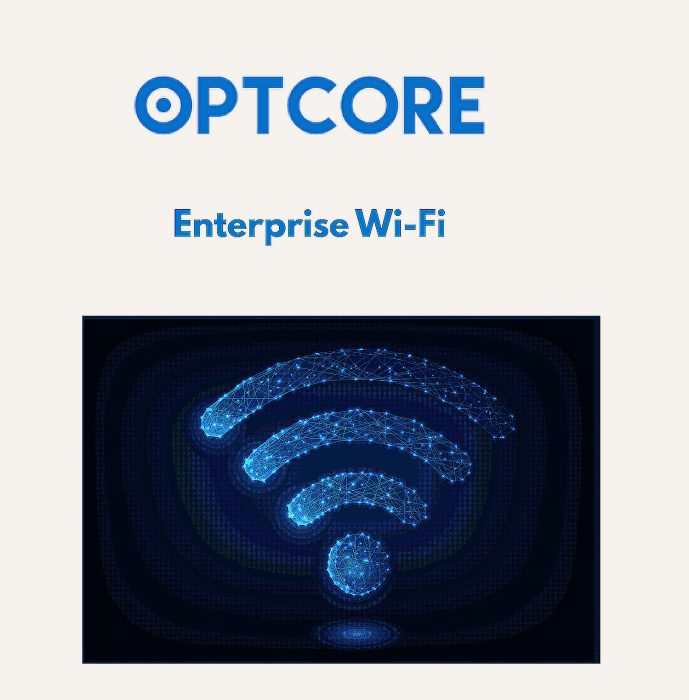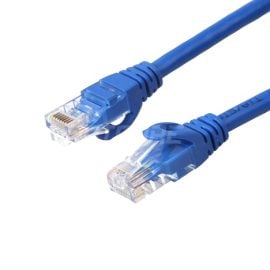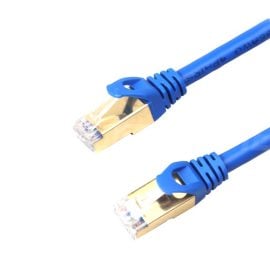Blog, Network Cabling
What is Enterprise Wi-Fi: A Complete Guide for Beginners
Family members are happily watching TV dramas via their robust Wi-Fi. However, enterprise Wi-Fi greets our eyes when we spread this wireless network to a corporate level.
As a wireless network used for businesses or campuses, enterprise Wi-Fi has richer features and more powerful functions than home Wi-Fi. Many devices and users use it to balance load and integrate access points. In particular, it covers a wide area, allowing for thousands of connections at the same time.
Table of contents
Enterprise Wi-Fi: Definition
Enterprise Wi-Fi is a wireless network popular with companies, campuses, and data centers. Unlike home Wi-Fi, it gives users more centralized management, better services, and safer solutions.

Some companies use Ethernet to handle their daily tasks. Our website has quality and affordable Ethernet network patch cables (e.g., Cat6, Cat7, and Cat8) to connect LAN network devices. Here are some items for your reference.
-
Cat6 Ethernet Network Patch Cable, Snagless Unshielded (UTP), PVC, Blue
Price range: US$ 0.85 through US$ 13.10 (Excl. VAT) -
Cat6 Snagless Shielded (SFTP) Ethernet Network Patch Cable, PVC, Blue
Price range: US$ 1.29 through US$ 17.70 (Excl. VAT) -
Cat7 Snagless Shielded (SFTP) Ethernet Network Patch Cable, PVC, Blue
Price range: US$ 2.20 through US$ 25.80 (Excl. VAT) -
Cat8 Snagless Shielded (SFTP) 25G/40GBase-T Ethernet Network Patch Cable, PVC, Black
Price range: US$ 2.25 through US$ 28.80 (Excl. VAT)
Enterprise Wi-Fi: Benefits
On Ubiquiti’s website, you can find three Wi-Fi models. They meet the growing needs of large companies, campuses, and stadiums. This is due to the many benefits of corporately used Wi-Fi.
Scalability
Wi-Fi networks used by enteprises are highly scalable, helping companies manage their networks more effectively. Growing companies use them to expand the network without often changing their internal facilities. Opening more branch offices also saves the need for extra network cables.
Cost-Effective and High Productivity
Companies using wireless networks often save on the costs of network cables. With fewer physical ports, maintenance costs are also lower. Enterprise networks with Wi-Fi CERTIFIED 6 support WPA3. So, IT teams have a greater capacity to use more advanced apps.
Smooth Collaboration and Mobility
Enterprise Wi-Fi makes data sharing much easier. Employees in different departments can work together to finish a key project in real time. They do not need to worry about locations and network connectivity.
Better Customer Experience
Customer satisfaction can be enhanced when businesses offer free Wi-Fi to their customers. The retail stores can help customers compare prices more easily by providing Wi-Fi access.
Security
Key business data can be safe because enterprise Wi-Fi ensures network segmentation and security. People without network access cannot steal confidential data in a company.
Real-Time Upgrade and IoT Device Support
Hospitals using enterprise Wi-Fi have fast and uninterrupted data flows. This makes sure of the timely treatment of patients. Wi-Fi supports IoT devices, so colleges can better check student attendance rates.
Enterprise Wi-Fi: Challenges
Security Issues
While using enterprise-level Wi-Fi networks, users may face some problems. The most serious one is how to maintain security when network devices are added.
UnReliable Connections
High data traffic rushes through the network. So, you need to think about how to make a reliable network connection during the installation.
Connectivity Problems
Users may be moving around different office buildings. Enterprise Wi-Fi should guarantee that they can connect their devices seamlessly.
Network Scalability Requirements
Businesses will grow rapidly, and their networks should be scalable. Therefore, enterprise Wi-Fi must meet this requirement.
Enterprise Wi-Fi: Devices for Deploying Enterprise-Level Networks
It is a big project to set up Wi-Fi networks for companies. Multiple network devices are needed. These contain switches, routers, servers, cabling, wireless access points (WAPs), network protocols, and network software.
Switches
Communication is possible when switches connect numerous access points and devices inside a network.
Routers
They are necessary parts for companies to make network connections. The function of routers is to route and manage data.
Cabling
Ethernet cables, optical fiber channels, and coaxial cables are vital media. They enable physical links between switches, access points, and gateways.
WAPs
Wireless access points (WAPs) link various devices and connect networks instead of wires. Enterprises should install enough access points to enhance the Wi-Fi signal to meet their needs.
Network Servers, Protocols, and Software
Network servers gather crucial network resources. They are key to connecting enterprise Wi-Fi networks. Network protocols like TCP/IP, HTTP, DHCP, and DNS also matter. They form the standards for sending and receiving data within a network. Network software covers many tools such as operating systems, monitoring applications, and security software.
Enterprise Wi-Fi Providers
Six large providers offer various quality services regarding enterprise Wi-Fi networks. The table below will help you know their merits and demerits.
| Provider Name | Pros | Cons | Use Cases |
| Nile Access Service | Enhanced enterprise security with campus zero-trust, no complexities due to standard design, day-0/1/N operations integrate with wired and wireless LAN, wide coverage, high capacity and availability, cost-saving with an as-a-Service consumption model | Investment based on each building, frequent needs of wired and wireless access network renewal | Companies needing to simplify network operations and avoid incurring upfront costs |
| Cisco Meraki | Cloud-managed Wi-Fi solutions, high-performance hardware components, day-0/1/N operations integrate with wired and wireless LAN | Ongoing investment into new products or licenses, difficult to integrate two separate solutions in a single network, professional services for larger deployments, unpredictable coverage, capacity, availability | Innovative companies focusing on wireless, switching, security, and SD-WAN |
| HPE Aruba | Cloud networking for distributed enterprises, effective policies on wired and wireless access, experienced in handling retail, education and high-tech enterprises | Network solutions need integration, HPE Greenlake Network as a Service (NaaS) needs verifying its value, professional services for larger deployments, unpredictable coverage, capacity, availability | User-centric, software that aims at automation, profiling, management and security |
| CommScope RUCKUS | Suitable for open areas for guest access, low budget | Issues of integrating with non-RUCKUS systems, simple user interface, may fail to meet enterprise security requirements, unpredictable coverage, capacity, availability | Event venues and hospitality industries |
| Juniper Mist | AI summaries improve user experience, Ease of provisioning via the cloud interface | Loose integration with Mist Wi-Fi, optimal configuration is based on AI notifications, may fail to ensure performance | Companies eager to use AI summaries to ease product troubleshooting for wired and wireless network management |
| Ubiquiti | Many Wi-Fi access point options at various prices, Intuitive workflows in the admin user interface and setup processes | Lack of advanced enterprise Wi-Fi capabilities, scale limitations for large enterprises, some functions may not be implementable | Small- to medium-sized businesses, IT teams looking for user- and budget-friendly solutions |
Enterprise Wi-Fi: How to Choose
Companies, campuses, and data centers should know how to select the right enterprise Wi-Fi network. This allows them to make seamless connectivity. The following aspects are what they need to consider.
Expenses
There is a need to lower maintenance expenses, upgrade software, and rebuy hardware. Companies should often compare the benefits with short- and long-term costs.
Security and Scalability
The network environment is complex, and hackers may attack enterprise networks for illegal gains. So, it’s better to select networks that enable zero-trust security and prevent cyber threats. As companies grow bigger, enterprise networks need higher scalability.
Compatibility
Enterprise Wi-Fi should be compatible with your network facilities. Therefore, you should tell your network needs and listen to advice from the provider before deciding.
Easy Management
It is vital to select enterprise Wi-Fi models. They need to allow centralized control and handle network management tasks with automation.
User Capacity
While choosing the enterprise Wi-Fi, you must know how many concurrent users the network can support. You can check the capacity for each access point and think about the locations.
Provider Reputation
Providers with a good reputation can offer you better network solutions. Comments on various providers are essential. You should ask for case studies to buy the most suitable enterprise Wi-Fi.
Conclusion
The digital age has higher demands for wireless networks. Enterprise Wi-Fi is critical in driving large companies to provide more secure network signals. Knowing the benefits, devices, trustworthy providers, and valuable methods for selecting enterprise Wi-Fi is crucial.
Reference
Read More
- What Is WPS on Router and How to Use It
- SOHO network: What is it and How to set up?
- What Is WPA? A Beginner’s Guide to Wi-Fi Protected Access
- How to Extend WiFi Range? 13 Tips to Boost Your WiFi Signal










